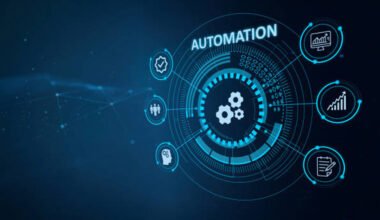Every morning, you’re drowning in spreadsheets, reports, and endless data points that need processing. Manual analysis consumes hours of your day, leaving little time for strategic thinking or actual decision-making. Here’s the reality: 95% of business managers are dissatisfied with their current performance review systems due to information inaccuracies and performance bottlenecks. It’s time to break free from this cycle of inefficiency and embrace intelligent automation.
With the foundation of AI’s transformative potential established, the first step toward automation excellence begins with ensuring your data flows seamlessly and continuously into your analysis systems.
1.Real-Time Data Streaming and Automated Preprocessing
Modern businesses can’t afford to wait for quarterly reports or monthly summaries. Your competitors are making decisions with real-time insights while you’re still collecting data manually.
A great example of how far automation has advanced is seen in the financial sector, where automated ai stock trading solutions now process market data continuously. These systems demonstrate how sophisticated analysis can happen without human intervention, processing thousands of data points every second.
Set Up Continuous Data Ingestion Pipelines
Building automated data pipelines transforms how information flows into your systems. Instead of manual uploads and CSV imports, you’ll create streams that pull data from multiple sources simultaneously.
Connect your CRM, marketing platforms, and operational tools through APIs. Most modern platforms offer webhook capabilities that push data automatically when changes occur.
Implement Smart Data Cleaning with Machine Learning
Raw data isn’t analysis-ready. AI for data analysis excels at identifying inconsistencies, duplicate entries, and formatting errors that would take humans hours to spot.
Machine learning algorithms learn your data patterns over time. They’ll automatically standardize date formats, fix spelling variations, and flag anomalies that need attention.
Configure Automated Quality Checks and Anomaly Detection
Quality control doesn’t have to be a manual process. Set up automated validators that check data completeness, accuracy ranges, and logical consistency.
These systems catch problems before they contaminate your analysis. When anomalies appear, you’ll get instant alerts with suggested corrections.
Build Self-Healing Data Workflows That Adapt to Changes
The most advanced workflows adjust themselves when source systems change. If a vendor updates their API structure, your pipeline adapts automatically instead of breaking.
This resilience keeps your automation in analytics running smoothly, even when external systems evolve without warning.
Now that your data pipelines are delivering clean, reliable information 24/7, it’s time to unleash AI’s true power by automatically discovering the hidden patterns and trends that human analysts often miss.
2.Intelligent Pattern Recognition and Trend Analysis
Traditional analysis relies on predefined queries and human intuition. AI pattern recognition goes deeper, finding correlations you’d never think to look for.
70% of analysts say AI and automation make them more effective in their roles. This effectiveness comes from AI’s ability to process complex relationships across massive datasets.
Deploy Neural Networks for Complex Pattern Discovery
Neural networks excel at finding non-linear relationships in your data. They’ll identify seasonal patterns, customer behavior cycles, and operational trends that traditional statistics miss.
Train these networks on your historical data, then let them run continuously. They’ll flag emerging patterns before they become obvious to human observers.
Automate Seasonal and Cyclical Trend Identification
Seasonal trends aren’t always obvious or regular. AI can detect subtle cyclical patterns across different timeframes, from daily fluctuations to multi-year cycles.
AI analysis tools automatically adjust for seasonality when making predictions, giving you more accurate forecasts than simple linear projections.
Create Predictive Models That Update Themselves Daily
Static models become outdated quickly in dynamic markets. Self-updating models retrain themselves as new data arrives, maintaining accuracy over time.
These models don’t just predict future values—they provide confidence intervals and explain their reasoning, helping you make informed decisions.
Integrate Natural Language Processing for Text Data Analysis
Customer feedback, support tickets, and social media mentions contain valuable insights hidden in unstructured text. NLP extracts sentiment, themes, and trending topics automatically.
This text analysis integrates with your quantitative data, providing a complete picture of your business performance.
While AI excels at uncovering complex patterns in your data, these insights remain worthless unless they’re presented in ways that drive immediate action and understanding.
3.Automated Visualization and Interactive Dashboard Creation
Static charts and manual reporting can’t keep pace with real-time insights. Automated visualization transforms discoveries into actionable intelligence instantly.
Generate Dynamic Charts That Respond to Data Changes
Your charts should update themselves as new data arrives. Dynamic visualizations adjust scales, highlight anomalies, and switch chart types based on the data characteristics.
Set up conditional formatting that uses color coding and visual alerts to draw attention to critical changes without human intervention.
Build Self-Updating Executive Dashboards with AI Insights
Executive dashboards need more than pretty charts—they need context and interpretation. AI-powered dashboards explain what the numbers mean and suggest potential actions.
These intelligent dashboards prioritize information based on business impact, ensuring leaders see the most critical insights first.
Create Automated Storytelling from Your Data
Numbers tell stories, but extracting those narratives takes skill and time. Automated storytelling transforms data points into coherent explanations of what’s happening and why.
The system identifies key changes, compares them to historical patterns, and generates written summaries that anyone can understand.
Implement Voice-Activated Data Exploration Tools
Sometimes you need answers immediately, without navigating through multiple dashboard screens. Voice interfaces let you ask questions in natural language and get instant responses.
“Show me this month’s conversion rates by channel” becomes as easy as asking a colleague, but with perfect accuracy and instant results.
Beyond creating beautiful charts and dashboards, the next level of automation transforms raw visualizations into intelligent, contextual reports that tell the complete story of your data.
4.Advanced Automated Reporting with Contextual Intelligence
Reports aren’t just collections of charts—they’re strategic communications that drive business decisions. Automated reporting combines analysis with context and recommendations.
Generate Intelligent Report Summaries Using Large Language Models
Modern AI can read your data, understand the implications, and write executive summaries that rival human analysts. These summaries highlight key findings, explain unusual patterns, and suggest areas for investigation.
Large language models understand business context, so they’ll frame findings in terms that matter to your organization’s goals and challenges.
Automate Competitive Analysis and Market Intelligence Gathering
Manual competitive research is time-consuming and often incomplete. Automated systems continuously monitor competitor pricing, product launches, and market positioning.
This intelligence feeds directly into your reporting, providing context for your performance metrics and identifying opportunities for strategic adjustment.
Create Personalized Analysis Reports for Different Stakeholders
Different departments need different insights from the same data. Automate daily analysis by creating role-specific reports that highlight relevant metrics for each audience.
Sales teams get lead quality and conversion data, while operations teams see efficiency metrics and resource utilization trends.
Implement Automated Alert Systems for Critical Business Metrics
Don’t wait for scheduled reports to discover problems. Intelligent alert systems monitor your key metrics continuously and notify relevant team members when thresholds are crossed.
These alerts include context about why the metric changed and suggest immediate actions to address issues before they escalate.
With comprehensive automated reports providing deep insights, you’re now ready to take the boldest step: letting AI make actual business decisions based on your daily analysis.
5.Autonomous Decision-Making Systems for Daily Operations
The ultimate goal of improving data analysis with AI isn’t just better insights it’s better decisions made faster. Autonomous systems can execute routine decisions without human intervention.
Build AI Models for Automated Investment and Trading Decisions
Financial markets move too quickly for human decision-making alone. AI models can analyze market conditions, assess risk, and execute trades based on predefined strategies.
These systems don’t replace human judgment they handle routine decisions while escalating unusual situations to human oversight.
Create Smart Resource Allocation Systems
Whether you’re allocating marketing budgets or staffing schedules, AI can optimize resource distribution based on predicted outcomes and current performance.
Smart allocation systems continuously rebalance resources as conditions change, maximizing efficiency without constant manual adjustment.
Implement Automated A/B Testing and Optimization
Manual A/B testing is slow and often incomplete. Automated systems can run multiple tests simultaneously, analyze results in real-time, and implement winning variations automatically.
This continuous optimization improves performance across all business areas, from website conversion to email marketing effectiveness.
Deploy AI-Driven Risk Assessment and Management Tools
Risk management requires constant vigilance and quick responses. AI systems monitor risk indicators continuously and take preventive actions when threats emerge.
These tools can automatically adjust credit limits, modify trading positions, or alert compliance teams about potential issues before they become problems.
These advanced automation capabilities require the right technological foundation, making tool selection critical to your success.
Final Thoughts on AI Analysis Automation
The transformation from manual analysis to intelligent automation isn’t just about saving time it’s about fundamentally changing how your business operates. Automate daily analysis through real-time data streams, intelligent pattern recognition, dynamic visualizations, contextual reporting, and autonomous decision-making systems. These five approaches work together to create a comprehensive automation framework that improves data analysis with AI while reducing human error and increasing response speed. The businesses that embrace this transformation today will have decisive competitive advantages tomorrow.
Your Questions About AI Analysis Automation Answered
How can artificial intelligence automate data analysis?
Data analysis automation is the process of collecting, preparing, and analysing unstructured data and then visualising, grouping, identifying patterns, detecting hidden themes, analysing sentiment, and generating predictive models using AI tools.
What are three ways AI can help you in your day to day job?
Forecasting: Taking in historical data and creating a reasonable forecast of what you can expect to see in the future. Predictive analytics: Predicting trends and future results based on historical data. Business monitoring: Real-time analytics on all key data points, from revenue to cost to customer experience.
Which industries benefit most from AI-powered daily analysis automation?
Financial services, retail, healthcare, manufacturing, and marketing agencies see the biggest returns from automated analysis systems due to their high data volumes and need for real-time decision-making capabilities.



